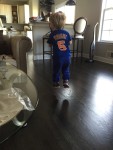Jacob deGrom
Pick out a problem with the Mets. The offense? The pitcher’s mechanics? Their starting to have some players get banged up? These and much more are very fair and valid. None of these are the biggest concern with the Mets.
The biggest concern is Jaxon Anthony deGrom.
There are some unspecified medical issues with deGrom’s newborn son. Fortunately, it’s not life threatening. Whenever something is wrong with your child whatever good news you receive is good news. That doesn’t mean the situation isn’t serious. Jaxon and his parents need every single one of your prayers right now. The only thing that matters is Jaxon is alright, and he goes on to lead a happy and healthy life.
At this time, deGrom needs to be a father and husband. He should take as much time as needed. With that said, I do wish the Mets put him on the DL rather than the bereavement/medical leave list. If deGrom went on the DL, his return would be open ended. With the bereavement/medical leave list, the Mets and deGrom are forced do make a decision after 3-7 days.
However much time deGrom and his family needs, he should take it. As far as I’m concerned, deGrom can miss the whole season. His son comes first. No, I don’t care if it costs the Mets the postseason or World Series. Sure I’ll be disappointed, but some things are more important.
My thoughts and prayers today are with Jaxon, Stacey, and Jacob deGrom.

With the Mets bullpen on fumes from a very short Steven Matz start and Logan Verrett making a spot start in place of an injured Jacob deGrom (our prayers are with him and his family), the Mets recalled Rafael Montero to add a fresh arm to the bullpen mix. The Mets needed an extra arm after the bullpen pitched 7.1 innings on Monday without any contributions from their long man. It was a waste of a move. At this point, it’s clear Montero is in Terry Collins’ doghouse, and Collins won’t use him until he’s burned out all of the other arms on the bullpen.
On Wednesday, Collins controversially pitched Jim Henderson despite him having problems locating his pitches and throwing more pitches he ever had in one game the previous night. Collins then proceeded to use Hansel Robles, who pitched 2.2 innings on Monday. Collins went to four relievers that day to preserve a 2-1 win.
On Friday, the Mets had a four run lead. Collins first turned to Antonio Bastardo to get out of a sixth inning jam. He then have way to Robles for 0.1 of an inning. At that point, the Mets had a four run lead in the eighth inning. Collins turned to Addison Reed to get the last six outs. Reed got five and allowed two runs in the process. Collins decided to let Jeurys Familia pitch for the fourth time in four games. Despite allowing a run, he recorded the save.
At no point in either of these games did Montero so much as warm up.
An argument can be made for not using Montero Wednesday because of how close the game was. The Mets were in the midst of a frustrating losing streak, and Collins wanted his best arms out there to get the win. With that said, there’s no reason why Montero didn’t pitch on Friday. After Bastardo got out of the jam, the Mets had a four run lead. That was the perfect spot for Montero.
Instead, Collins asked both Bastardo and Reed to pitch over an inning. He asked two middle relievers to pitch more than an inning rather than asking the long man in his bullpen to pitch more than an inning. Collins was ready, willing, and able to once again tire out his bullpen rather than putting Montero in a game to preserve a four run lead. At this point, it’s fair to say either Collins doesn’t trust Montero, has him in his doghouse, or both.
It’s strange to think it’s reached this point when Collins has tried to get the most out of Montero.
Last August when things were starting to take off for the Mets, Collins drove to Port St. Lucie to have a conversation with Montero in order to tell him the Mets still needed him. At that time, Montero was dealing with shoulder issues. The Mets insisted there was nothing wrong while Montero felt like it prevented him from pitching. Montero tried to make that comeback, but he would have a setback in a rehab start. His season was over.
In Spring Training, Collins again took time to deliver a special message for Montero. As Tim Rohan of the New York Times reported, Collins told Montero, “Get your act together. We haven’t forgotten about you. We still want you.” Collins gave him the start in the Mets first Spring Training game. Montero allowed the first five guys to reach base. In total, he allowed four runs, four hits, and two walks in one inning of work. Montero would not pitch in another game, and he would be in the first group of Spring Training cuts.
At this point, the Mets need Montero. He’s gotten his act together with some mechanical adjustments in Triple-A. However, it’s too little too late. Collins has either forgotten him or doesn’t want him anymore.

Due to the stress Jacob deGrom‘s injury and Steven Matz‘s short start out on the bullpen, the Mets were forced to call-up Rafael Montero to add a fresh arm to the bullpen. Rather than out deGrom on the DL or demote another pitcher, the Mets sent down Eric Campbell. Even with deGrom looking more and more like he will miss his next start, the Mets still won’t put him on the DL. Essentially, the Mets robbed Peter to pay Paul.
With a weekend Interleague series in Cleveland, the Mets can get away with a short bench. While it does limit their ability to pinch hit and make defensive substitutions, they should be able to navigate the situation because they won’t have to pinch hit for a pitcher. However, come Monday, they’re back to playing National League ball, and they’re going to need a full bench.
Whatever your feelings on Campbell is, he’s not going to be eligible to be recalled. Unless deGrom (or someone else) goes on the DL, Campbell will have to spend 10 days in the minors. Looking over the Mets 40 man roster, there would be three eligible candidates: Dilson Herrera, Matt Reynolds, and Brandon Nimmo. Now with one extra spot left on the 40 man roster due to Zack Wheeler being on the 60 day DL, the Mets could recall another player like a Ty Kelly.
In reality, the decision is between Reynolds and Kelly. Nimmo isn’t quite ready, and even if he was, the last thing the Mets need is another outfielder. Herrera still hasn’t started playing games in the field yet due to a sore shoulder, and even if he has been, the Mets see him as the second baseman of the future. They’re not wasting service and development time for him to be on the bench.
Kelly is 27 years old, and he has yet to play in the majors. He plays second, third, and the corner outfield positions. He’s a very disciplined hitter, who is extremely selective at the plate. For reasons that aren’t completely clear, he’s spent five seasons in Triple-A, and he’s never played a major league game. Overall, the truth really is Triple-A is his ceiling. At best, he’s a AAAA player.
Even if that assessment was wrong, it’s still not time to call-up Kelly. First, the Mets would have to add him to the 40 man roster and would not be able to denote him unless he clears waivers. Additionally, his skill set doesn’t match what this team needs. There’s no room for him in the outfield. Terry Collins is going to play Neil Walker almost everyday. So in essence, while Kelly has some versatility, the positions he plays do not match the Mets’ needs.
Accordingly, Reynolds is the player the Mets need to recall. During Spring Training and this early minor league season, Reynolds has played every infield position but first. His addition to the major league roster would create more flexibility across the infield. It would permit Collins to sit both Asdrubal Cabrera and Lucas Duda in the same game. Additionally, it would permit Collins to double switch with any player with the full knowledge that there’s another player on the bench who is fully capable of playing any position should another double switch be needed or there was an injury.
Offensively, Reynolds is a right hand batter who profiles better at the next level than Kelly. He’s not as patient as Kelly, but then again no one is. Reynolds profiles as a gap to gap line drive hitter. He does have more pop in his bat than Kelly. More importantly, at the very least, Reynolds projects as a bench player.
If Reynolds is going to wear a Mets uniform past smiling and waiving before Game One of the NLCS, he’s going to be a super-utility man in the mold of Flores or Joe McEwing. Reynolds has worked hard at it during the offseason and Spring. He knows this is his future, and he’s fully embraced it.
Better yet, he’s scorching hot right now. He’s hitting .353/.476/.529 with a homerun in five games. In those fives games, he’s played second, third, and short. At this point the only plausible reason for not calling up Reynolds is the Mets want to have a short bench.
Reynolds has earned his shot, and he’s playing well. It’s time for the Mets to call-up Reynolds.

On Wednesday, Logan Verrett pitched six scoreless innings against at the Miami Marlins. Verrett allowed three hits, two walks, and six strikeouts. It was a remarkable start for a pitcher who was never supposed to be here.
Heading into the 2015 season, the Mets declined to put Verrett on the 40 man roster thereby exposing him the the Rule 5 draft. He was selected by the Orioles, who waived him when it was apparent he was not making their team. He was picked up by the Rangers, who made their Opening Day roster.
In very limited duty for the Rangers Verrett struggled. He pitched nine innings in four appearances with a 6.00 ERA and a 1.667 WHIP. Verrett was offered back to the Mets, who accepted him back and sent him to Triple-A.
Verrett first came up with the Mets in June to help an exhausted bullpen. He would pitch 12.1 innings over the course of six appearances. He had a sterling 0.73 ERA and 0.649 WHIP. Batters were only able to hit .100/.178/.100 against him. He recorded his first save. Despite this stellar performance, he would be sent back down to the minors to make room for Jenrry Mejia, who was returning from his first PED suspension.
In Verrett’s second stint with the Mets in August, he would further prove his value. With the Mets needing to keep their young pitching staff fresh for the postseason, especially Matt Harvey, Verrett was called upon to make some spot starts. In his first start, he threw eight shutout innings in Coors Field of all places. He would follow that up with a couple a relief appearances and another strong spot start against the Marlins.
In total, Verrett would pitch in 14 games with the Mets making four spot starts. He was 1-1 with one save, a 3.03 ERA, and a 0.879 WHIP. In a season of incredible performances from a myriad of players, it’s easy to overlook Verrett’s contributions.
Then again, it’s been easy to overlook Verrett. In an organization that seemingly churns out nothing but pitchers throwing 95 MPH plus striking people out left and right, Verrett uses all four of his pitches, including a 91 MPH, to get outs. While each and every Mets draft pick gets attention, he simply flew under the radar honing his skills and becoming a better pitcher. Perhaps that is why he became the first ever draft pick from the Sandy Alderson regime to play in the majors.
In 2016, Verrett made the Opening Day roster, and he’s back to doing what he does best – pitching in whatever role the Mets need. In his spot start in place of the ailing Jacob deGrom, Verrett threw six shutout innings. Not only did he help prevent the Mets from getting swept by the Marlins, but he also pitched somewhat deep into the game to give a fatigued Mets bullpen some rest.
As we know, the Mets never intended to have Verrett start that game. Frankly, no one thought he would pitch a game for the Mets. However, because the Mets got lucky with the Orioles and Rangers overlooking how good he truly was, like the Mets once did themselves, Verrett is pitching in the majors showing the world what a truly talented pitcher he is.
No one is going to overlook him ever again.

After the Mets bullpen had to pitch 7.1 innings on Monday with Steven Matz‘s terrible start, and Logan Verrett having to come out of the bullpen to start in place of Jacob deGrom, the Mets were forced to make a move to add a pitcher to the roster.
There were plenty of good options available to them.
The Mets could’ve utilized deGrom’s paternity leave and called up Rafael Montero. However, the Mets didn’t want to do that because they then couldn’t backdate a potential deGrom DL stint to last Saturday. The Mets could’ve just placed deGrom on the DL, but for some reason they do not appear ready to do that. Apparently, that April 19th game against the Phillies is a must win, and you need deGrom to pitch in that game if at all possible.
No, the Mets decided to demote a player. Looking over the roster, the only pitcher who realistically could be demoted is Hansel Robles. He seems like a natural choice as he pitched 2.2 innings on Monday, and he could use an extra day or two. If Montero falters, the Mets could recall Erik Goeddel or Sean Gilmartin to take his place on the roster.
In this scenario, Robles would have to stay in the minors for 10 days unless the Mets put deGrom (or someone else) on the DL. Given Robles’ current role, losing him for 10 days would be palatable. Montero, Goeddel, or Gilmartin could easily be the long man and/or last man in the bullpen.
Instead of the Mets following the reasonable course of action, they determined it was in their best interests to demote Eric Campbell. In essence, the Mets decided to go with the worst possible choice.
Now,there is nothing wrong per se with demoting Campbell. He’s a career .230/.315/.325 hitter. He has good attributes as a player, but nothing that Campbell has done in his career would ever prevent him from being demoted. However, if he’s being demoted, it should be because the Mets are calling up another position player like Matt Reynolds, not because they are adding a pitcher to the roster.
The Mets demoting Campbell for Montero shortens the Mets bench. In a world where you have David Wright on your team, you should never shorten your bench. On any given day, Wright can wake up sore and not be ready to play. If that happens, not only are you down another player, but you also have no infielders on your bench.
By the way, the Mets are playing a day game after a night game. Terry Collins has said there’s no hard-and-fast rule stating Wright must sit a day game after a night game. However, it’s also true that the Mets have so far refrained from playing Wright in a day game after a night game. No one knows how his back will respond to it. No one knows if he will be able to get loose in time to play a full nine innings.
Instead of taking this into account, the Mets thought it would be best to potentially have no infielders on the bench. The Mets thought it would be best to realistically only have two options on the bench for Wednesday’s game (Collins is loathe to pinch hit with his catcher). Also, apparently, the Mets do not foresee the need to have more than two pinch hitters available in a game where the starting pitcher hasn’t pitched in almost a month and wasn’t stretched out in Spring Training. No, the Mets are setting forth a gameplan where they will have Verrett go deep in the game, and they will be alright with just two bench players. What could go wrong?
The Mets are in the midst of a four game losing streak and would rather potentially sacrifice the the last game of the homestand to give themselves the best possible shot of winning a game against a terrible Phillies team in Philadelphia. The Mets apparently didn’t learn their lesson on Monday about the perils of having a shortened roster.
Overall, the Mets put themselves in a tough position all because they’ve deemed an April game in Philadelphia a must win. Why else wouldn’t you put an injured pitcher who is already missing a start and bullpen sessions on the DL?

React to last night’s loss the way you want. No matter what your reaction may be, we can all agree that the Mets have some work to do. This includes the pitching staff.
Before last night’s loss, the Mets lead the National League in ERA. After Steven Matz‘s dud last night, the Mets are now ranked sixth. They went from a 2.08 ERA to a 3.40 ERA. It’s a warning of overlying on small sample sizes. It’s also a reminder that it’s really about the process. While it’s a results oriented business, the pitching coach needs to focus on things like the pitcher’s mechanics and not his ERA.
In that respect, Dan Warthen has some work to do as three of his starters have some mechanical issues.
Steven Matz
Last night, Matz was terrible. There are a number of things you can point to as the reason like the long layoff. However, as Kevin Kernan reported in the NY Post, Matz’s mechanics may have been to blame:
He looks like a young guy who needs a month in Triple-A to clean up some things,” one veteran scout at the game told the Post.
Looking at last night’s game, there was no doubt Matz needs some work. He wasn’t fooling anyone last night, and the Marlins were on top of his pitches. Preferably, Matz can do that work with Dan Warthen instead of Triple-A. Regardless of where he does it, Matz needs to need to get himself right.
Jacob deGrom
The talk throughout Spring Training was Jacob deGrom‘s fastball ranging between 91 – 93 MPH. That is down from the 96 MPH fastball he averaged last year. There were a number of reasons posited why that was the case from him starting getting ready for the season later to him saving bullets for the regular season to him getting nicked up a couple of times during Spring Training.
In his first start of the season, deGrom was still averaging 92 MPH. Some said there was no need for caution because he looked dominant at times even without the extra MPH on the fastball. Some later speculated it might’ve been the result of his lat injury. However, on the April 11th edition of MLB Tonight, Pedro Martinez stated that deGrom was dropping his arm angle. It was his belief that if deGrom fixed his arm angle the extra MPH could return to deGrom’s fastball.
Matt Harvey
This season is supposed to be the season for Matt Harvey. He’s another year removed from Tommy John surgery. He’s got his slider back. The only thing he had to worry about was going out there and dominating like he did in 2013.
It hasn’t started out that way. Harvey was 8-0 in April coming into this year. This year he’s 0-2 with a 4.63 ERA and a 1.463 WHIP. At times, he seems to have difficulty locating pitches. Harvey isn’t blaming his bladder problems. As Neil Best of Newsday reports on Opening Day, it’s a mechanical issue:
“I felt alright,” Harvey said. “There were times I felt fine and other times when it was hard finding a rhythm and getting my release point.”
After Sunday’s loss to the Phillies, Harvey’s day changed on one pitch he left out over the plate. Again, as Kevin Kernan of the NY Post reported, it was a mechanical issue as, “Harvey said he didn’t get the arm extension on the killer 1-2 slider.” As Kernan further reported the coaching staff is concerned enough for Dan Warthen to start “studying film to see what the issue is with Harvey.”
Dan Warthen is going to study film for at least three of his starters. Fortunately, it is still early in the season. The Mets have plenty of time to figure things out. The pitching is going to be there, and yes, the offense will as well. However, while the offense is figuring things out, the Mets need their pitching. As we saw last year, this Mets staff can keep even the most abysmal of offenses afloat. As we saw last year, the Mets pitching can carry them to the World Series.
It’s the Mets pitching that is going to win them the World Series this year.
Editor’s Note: this article first appeared on metsmerizedonline.com
The Mets sent out Steven Matz, who is the proverbial fourth member of what had been touted as the Big Four. Mets fans all hope each of these pitchers will be future Hall of Famers. Tonight, Matz did a pretty good impersonation of Tom Glavine.
Like Glavine, Matz allowed seven runs to the Marlins. At least Matz lasted a little longer. Matz’s final line was 1.2 innings, six hits, seven earned, two walks, and one strikeout. Before the game, Matz was 4-0 with a 2.27 ERA. This year, he’s 0-1 with a 37.80 ERA.
In the fateful second inning, seemingly every Marlin got a hit including Barry Bonds and Don Mattingly got hits. Of course, Giancarlo Stanton provided the exclamation point:
.@Giancarlo818 puts an exclamation point on the 2nd inning!#StantonSmash | #LetsGoFish pic.twitter.com/rTwMWtl5HI
— Miami Marlins (@Marlins) April 12, 2016
It needs to be constantly reiterated, but Bonds seems to be having a very real impact on this Marlins team. Six of their eight regulars are hitting over .300. They had no problem hitting Matz. This is a young Marlins club with a lot of offensive talent. If they realize that potential, it’s a definitive blow to the Mets chances to return to the postseason . . . especially with how this club plays the Marlins.
As for the Mets, their bullpen did a yeoman’s job. Hansel Robles pitched 2.1 innings allowing four hits, one earned, one walk, and three strikeouts. Antonio Bastardo pitched 1.1 innings allowing four hits, two runs, one walk, and two strikeouts. Addison Reed pitched 1.2 innings with no hits, no runs, and four strikeouts. Jeurys Familia was pressed into action even though he has the flu. Jerry Blevins pitched the ninth. The night was such a disaster that Blevins finally allowed a hit in his Mets career. It was an infield single to Dee Gordon with two outs in the ninth.
The Mets might’ve avoided burning through their entire bullpen like that if they would’ve just put Jacob deGrom on the DL. Sean Gilmartin, who was very effective as the long man last year, could’ve soaked up some of those innings. It would’ve been all the more imperative with Logan Verrett going on Wednesday.
Offensively? Well the Mets had seven hits and three runs. All of the runs came after the game was over. Two of those hits were from David Wright, who despite his career being declared over, has been the Mets best offensive player so far this year. He’s hitting .333 with a .478 OBP. Perhaps that’s the reason why the man with the bad back played all nine innings in a 10-3 blowout.
All kidding aside, the Mets decision making in this young season has been perplexing. Terry Collins bats three lefties bunched up together every day (with his splits, Neil Walker is effectively a left handed hitter). Jim Henderson leads the Mets in appearances despite not having pitched in two years and coming off a second shoulder surgery. Remember that next time Collins gets emotional over Johan Santana. At least Collins isn’t to blame for the team’s mismanagement of the deGrom/bullpen situation.
With all that said, this is a game the Mets should just forget about. It’s another game to forget in what has been a mostly forgettable start to the season. Fortunately, momentum is the next day’s starting pitcher, and Noah Syndergaard is scheduled to pitch tomorrow. So, in that sense, the Mets have some momentum going.

There’s no blaming the Mets for Jacob deGrom‘s right lat injury. Injuries happen. However, we yet again have to question how the Mets handle injuries and their roster.
At the outset, the Mets are skipping deGrom’s start on Wednesday. He also isn’t going to throw in the bullpen for the time being. This is a very reasonable course of action. There’s no need rushing deGrom back in April possibly causing him further injury. With that said, there’s no reason why deGrom hasn’t been sent for an MRI.
It was just last year the Mets dealt with Steven Matz and his lat. The Mets thought he was fine. They didn’t send him for an MRI, and they let him make his next start. As we discovered, he shouldn’t have made that start. He wouldn’t throw another pitch for the Mets for another two months. The Mets treatment of Matz follows a pattern. It’s at this point, we’re obligated to review Jared Diamond’s breakdown in the Wall Street Journal of how the Mets downplay injuries:

For a second, let’s be optimistic about deGrom’s injury. Let’s assume it really is tightness and not worse. Let’s assume an MRI really isn’t needed. Why not put him on the DL anyway?
With deGrom missing a start, Logan Verrett will take his spot in the rotation. This is the same Verrett who pitched yesterday. This means he will be starting on two days rest on Wednesday. He also isn’t fully stretched out. He only threw 15.2 innings in eight Spring Training games. Long story short, the Mets bullpen is going to be taxed.
The bullpen is also going to be one man short as Verrett rests from his start.
Instead of having a short bullpen, the Mets should just put deGrom on the DL. He’s already missing one start. If deGrom were to go on the DL, he would be eligible to make his next start on Sunday, April 24th instead of Tuesday, April 19th against the Phillies. Despite the Mets losing two out of three to the Phillies this past weekend, the Mets should still be able to win with Verrett on the mound.
In turn, deGrom can use that time to rest, not rush back, and not exacerbate his lat injury. He can be home when his wife gives birth. He can spend some quality time home with his newborn son before going back on the road. deGrom can get his mind and his body in the right place before pitching again.
The Mets need to put deGrom on the DL right now.
Editor’s Note: this was first published on metsmerizedonline.com

The season has gotten off to a rocky start and increasingly, it is becoming apparent that there are two types of Mets fans – Optimistic and Pessimistic. Here’s the breakdown:
Optimistic: the Mets won in 1969 and 1986. They win in years which have a 6 in them. It’s 2016!
Pessimistic: Tell that to the 1962 – 1968 Mets and the 1976 Mets. Also, someone probably should’ve told that to Carlos Beltran when he didn’t swing the bat.
Optimistic: The ’86 Mets began the year 2-3, and they lost two games to the Phillies.
Pessimistic: The 1992 Mets were also a high profile team people thought were World Series contenders that opened the year 2-3. By the way, the 1986 Phillies were a decent team. The 2016 Phillies are horrendous.
Optimistic: Yoenis Cespedes seemed to get off the snide. He went 2-4 with a homerun and two RBI.
Pessimistic: He’s still batting only .200, and did you see him drop that ball in Kansas City?
Optimistic: The Mets have the best ERA in baseball.
Pessimistic: Matt Harvey has been terrible. It’s only a matter of time before we discover Jacob deGrom needs surgery or he will be out half the year. By the way, the Mets have the best ERA, faced an awful Phillies team, and they’re still under .500.
Optimistic: The bullpen has been off to a terrific start.
Pessimistic: You must’ve missed yesterday’s game when Addison Reed melted down like it was Game 5 of the World Series.
Optimistic: David Wright has looked good to start the year.
Pessimistic: His throws have been terrible, and he’s already had to miss a game.
Optimistic: Neil Walker and Asdrubal Cabrera have looked great up the middle.
Pessimistic: Anything would’ve been an upgrade. By the way, they’re not hitting, and it hasn’t translated to wins. Speaking of wins, the Nationals are 3-1. Coincidentally, they have Daniel Murphy, the guy who carried the Mets in the postseason, is a National. He’s hitting .462/.611/.923.
Optimistic: This team is built to win the World Series, and I’m going to enjoy every single part of the ride.
Pessimistic: I don’t know what team you’re watching.

In Jacob deGrom‘s first start of the year, he went out and dominated the Phillies. Normally, this would be reason to celebrate because it’s a sign deGrom is picking up where he left off last season. Unfortunately, there were some real problems with the start.
Most importantly, deGrom left the start with right lat tightness. This was the latest injury deGrom has had this year. During Spring Training, deGrom also a sore thigh and a stiff back. Neither of the latter two injuries prevented him from getting ready for the 2016 season or taking the mound against the Phillies. He’s been nicked up, but as of right now, there is no discussion of putting deGrom on the disabled list.
There’s something important to note here. deGrom is suffering from a TIGHT lat, not a TORN lat like Steven Matz suffered last year. Any discussion of deGrom missing any period of time is very premature.
With that said, you are left to wonder if any one of these injuries, or a combination thereof, has helped cause deGrom’s drop in velocity.
After a 2015 season in which deGrom averaged a 96 MPH fastball, his velocity has noticeably dipped this year. During Spring Training, deGrom was throwing his fastball between 91 – 93 MPH. Despite hopes that he could ramp it up during the regular season, deGrom’s fastball only averaged 93 MPH. So while he ramped it up a bit, we was still three MPH slower than where he was last year.
It’s natural to question if the dip in velocity is due to deGrom getting nicked up here and there. On MLB Tonight, Pedro Martinez presented an alternative theory. He thinks deGrom is dropping his arm when he’s pitching thereby causing the decreased velocity. Therefore, if deGrom improves his mechanics, he should be able to regain his velocity.
Even if deGrom never finds his velocity, he can still be a very effective pitcher. In 2014, deGrom’s fastball averaged somewhere between 93 – 94 MPH. That year, he was 9-6 with a 2.69 ERA in 22 starts. By the way, this was good enough for him to be named the National League Rookie of the Year.
While deGrom’s health and velocity is something to keep an eye on, we do know that deGrom can pitch very effectively even without the 96 MPH fastball. Most likely, deGrom just needs a day or two off to get some rest. Hopefully, he gets it now because once his son is born, he’s not getting any rest or sleep.